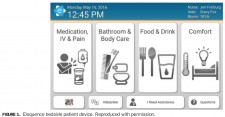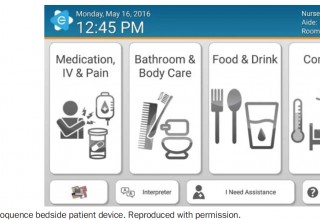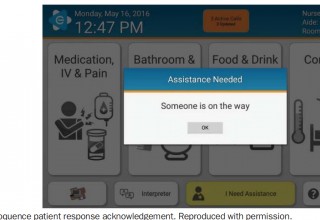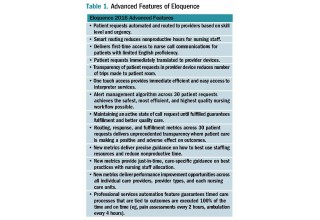
ANN ARBOR, Mich., May 22, 2018 (Newswire.com) - In one of the latest publications evaluating Eloquence, “Perspectives of 30 English Patients on Call Light Technology, Eloquence Revisited” by Montie, et al., patients report their insight on an advanced nurse call technology.
Quoting the study, “Eloquence offers a plethora of technologically advanced features in call light systems (Table 1); some examples include touchscreen device for patients (Figure 1), a nurse handheld mobile device (Figure 2), and an automated algorithm that assigns priorities of patient calls to the most appropriate healthcare personnel (i.e., RN for medication request or a nurse technician for a request for water). In addition, Eloquence provides an automated acknowledgment response status of the patient request (Figure 3).”
I just think it would make it easier on both the staff and the patients. As far as cutting the response time, because they would know what you need.
Patient
Patients in this study, ranging in age from 21-85, believed Eloquence would benefit their healthcare and, not only found it user-friendly, but found it easier to communicate with their healthcare provider than with the current technology. Patients appreciated that Eloquence was more technologically advanced, felt more familiar, was more efficient and thought it would also help their nurses. Quoting the study, patients explained:
"It’s very modern. It's 21st century… It reminds me of everything else that's in my life like radio, my phone, TV.
"Well, it responds right back to you. The other one, the machine is just flashing…
"They (nurses) would understand the need before they got here. They would have a heads up. When we call them and they come in here, they have no idea what I need at that point.
"I just think it would make it easier on both the staff and the patients. As far as cutting the response time, because they would know what you need."
Patients believed Eloquence would improve the healthcare they receive, commenting that Eloquence could “streamline care.” According to Montie, et. Al, “by streamlining, participants believed that nurses and other healthcare providers could not only prioritize their call light requests but also prioritize patient care.” Quoting the study, patients expounded on their experiences:
"[Eloquence] is more quicker. With this old one, you push it, they come down, ask you what's wrong, and you tell them you need medication. (With Eloquence) They already know what kind of medication you take. With the new one, you push 'pain meds,' and they can pretty much have it stat instead of coming in and having to leave back out … It just saves time.
"…I think it (Eloquence) would be quicker because I wouldn't be wasting a nurse's time when it was only an aide that I needed. Right now, when you push the button, you get either aide or a nurse…"
This evaluation also provided additional feedback, of which most was incorporated into updated versions of Eloquence during its commercialization. Patient-led changes to the Eloquence design included larger font size and flexible deployment (bedside tablet versus TV display with navigation by remote control or pillow speaker). Many other suggestions are features that were already present and simply had not been shown during the demonstration.
About Eloquence Communications, Inc.
Eloquence Communications, a healthcare IT company founded by Dr. Lance Patak and Dr. Bryan Traughber, was established to help healthcare facilities achieve outcomes improvement in a meaningful way that is clinically and financially relevant. Eloquence streamlines nursing workflow achieving unprecedented transparency, efficiency, prioritization of care, optimal guidance with staffing allocation and staffing mix, all while reducing non-value added time for skilled providers and enabling safer, better quality care.
For more information about Eloquence Communications, Inc., contact:
Eloquence Communications, (855) 422-3567
Montie M, Shuman C, Galinato J, Patak L, Titler M. (2018). Perspectives of 30 English patients on call light technology, Eloquence revisited. "Comput Inform Nurs";36(1):27-34.
This research was supported by Small Business Technology Transfer Program of the National Institutes of Health (NIH) under award number R42MD006149.
Source: Eloquence Communications, Inc.
Share:




